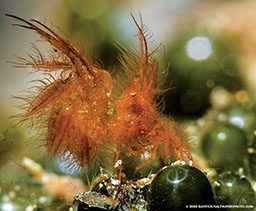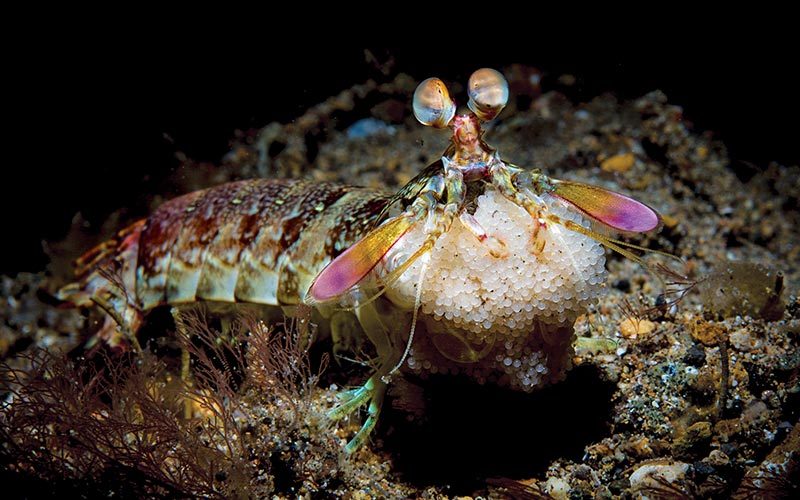My first dive trip to Lembeh Strait was an eye-opening experience that forever changed my approach to diving and shooting underwater. I had always considered myself to have a good eye for finding unusual subjects and even took a bit of pride in my ability. But when I was introduced to my first real dive photo guides, I realized just how little I really knew.
As I prepared for my first dive my guide gave a short but detailed briefing. Actually it was more of a strategy session, covering specifics such as the hand signals he used and how we would work together to photograph our target subject. This was a step above any dive briefing I’d been given in the past, and by sticking to the plan we successfully photographed my first pygmy seahorse on that initial dive.
The differences between a dive photo guide, or spotter, and a typical divemaster can be summed up easily: A dive photo guide’s primary role underwater is to keep an eye open for critters and to assist the diver in finding and photographing subjects. A divemaster is mainly concerned with the safety of the group (although he or she may point out a few things along the way).

Genesis of the Dive Photo Guide

In the late 1980s Larry Smith took the helm of a then no-name resort in an obscure corner of North Sulawesi, Indonesia, now known as Lembeh Strait. Smith’s passion for diving and obsession with exotic animals were already legendary when he began to train his local divemasters in the fine art of the critter hunt. He and his staff began to explore the area for new dive sites, and he soon realized the new dive staff had a natural talent for finding the critters. The news soon spread, and Smith’s efforts began to be noticed throughout the dive community, particularly among underwater photographers. Soon the resort was buzzing with photographers, all clamoring to get images of these seemingly new and rare critters of the strait. With hard work and dedication he and his crew carved out an entirely new niche in the dive industry now known as “muck diving” and established the role of the dive photo guide.
Today, finding the right guide has become an important consideration for underwater photographers. It’s been said, “It’s not the dive site, it’s the dive guide on the site” that makes a dive come to life, and that has definitely been my experience.
Getting the Most From Your Collaboration
Preparation is key to getting the most from your guided experience. Knowing the possible subjects and creating a list before your trip of what you would like to see or photograph is a great way to start. There is a Holy Grail of exotic macro life specific to any destination, and the guide will already know what the marquee subjects are.
One thing your guide won’t know is what your portfolio already has in abundance. So if longnose hawkfish are redundant to you, let your guide know. Or if you truly covet a photo of a blue-ringed octopus, likewise tell your guide. If you sense that your guide is excited about something or there is a subject he or she really wants to show you, then it’s certainly worth investigating. Many times that familiar tug on my fin afforded me an opportunity to see something completely off the charts. An opportunity to photograph something unusual can even arise through observing your guide’s body language underwater, so pay attention.

The Torch, Staging and the Stick
One of a guide’s most valuable tools is his torch, which is used regularly to find subjects of all shapes and sizes during the day and at night. A strong light with a tight beam can scan algae, peek under coral heads, peer into crevices and scan the sandy bottom, perhaps prompting movement in an otherwise stoic or cryptic subject. This slight movement is often all that’s needed for a guide’s eyes to discover a subject. Lie-in-wait predators such as frogfish and lacy scorpionfish survive by remaining motionless and relying upon their camouflage to hide and hunt. To the untrained eye even these somewhat gaudy subjects can blend in perfectly with their habitat.

Staging is a practice in which a guide assists a photographer in composing an image by encouraging the subject to move into a more photogenic position. Some resorts and photographers are ethically opposed to staged photos — for good reason — but it is naïve to assume staging doesn’t happen. It may be as benign as enticing an octopus to engage its curious nature or using a blade of seagrass to gently brush the subject, but it also might be egregious — puffing pufferfish or holding turtles underwater, for example. Most guides will know such behavior is wrong and won’t be tolerated by their clients, but a fine line separates engagement and harassment. Each guide will have his or her own standards regarding this practice; a simple tap on the hand or a grunt will alert the guide that enough is enough and it’s time to move on. Praising your guide topside for being gentle is a good practice for promoting a more eco-friendly approach to the hunt. A compliment is much more powerful than a complaint; remember you’re a team and need to work together — mutual respect can go a long way.
Nearly all dive photo guides now carry a “muck stick” to use in a variety of ways in the pursuit of different subjects. Pushing aside algae or tickling the foot of a crinoid with his stick, a guide can move quickly around a dive site, probing and searching. To some divers this activity might seem a bit heavy-handed or intrusive, but in the right hands a muck stick can be just the opposite. Some guides will carry several differently sized sticks, zip ties, a small piece of monofilament line or, my favorite, a chopstick. All of these can be used to tickle a subject, encourage movement or stabilize a diver without destroying habitat or unduly disturbing a subject.
Communications Above and Below

Communicating effectively above the waterline will increase efficiency below, where time is limited, thus improving your ability to collaborate with your guide and subjects. Occasionally your bottom time will be consumed searching for a specific subject, so when it’s finally located it’s important to be ready — relax and concentrate on working the subject with your guide.
Some of the most productive dive sites tend to be the busiest, so it’s also important to learn how to communicate with your guide underwater. Some guides use a honker, shaker or tank banger to signal their guests. Unfortunately these approaches also signal everyone else on the dive site, and a photo melee may ensue. A quieter method will allow guide and diver to move around a site and attract very little attention, even among a crowd, while still communicating with each other. A low-pitched grunt and a few hand signals can say it all. To further maximize your bottom time, try to arrange for a low guest-to-guide ratio or, better yet, private one-on-one excursions. Many resorts will offer such services at a premium, and the results generated may be well worth the added cost.
Crustaceans and Nudibranchs
Ornate colors and interesting body structures are just a few of the reasons why crustaceans and nudibranchs are desirable photo subjects. But finding them isn’t as easy as you might think. Tiger shrimp, harlequin shrimp, hairy shrimp, bumblebee shrimp, boxer crabs and many of the light-sensitive nudibranchs don’t just sit on top of the reef. Finding these subjects may require searching through rubble and dead coral, for example. A guide who knows where to look and how to photograph these animals can be much less intrusive than a diver who digs into fragile habitat without knowledge of the area.
Using your field ID book as a wish list, poll your resort’s guides: Ask what they are good at finding or what is seasonal, and let them know if there is a particular subject that you would like to see. Chances are good that something special might come to mind, which always adds excitement to a dive.
Many guides who live in remote regions of the world have dedicated themselves to diving, sometimes despite local pressures to fish or collect. Their knowledge of the local marine life can be extraordinary, and their insights about behaviors can be remarkable even in the absence of formal education. Many guides have been responsible for discovering new marine animals.
The close working relationships of divers and photo guides can forge lifelong friendships and create incredibly rewarding and enjoyable life experiences. It is hard to match the pure elation of finding a wish-list subject, discovering something new together or showing a diver a subject he has traveled thousands of miles to see.
How to Say Thanks
- Give a cash tip in the local currency. (Follow resort protocol in terms of when and how to give a gratuity.)
- Share proceeds or a contest prize.
- Tell the resort management how much you appreciated your guide.
© Alert Diver — Q4 Fall 2015